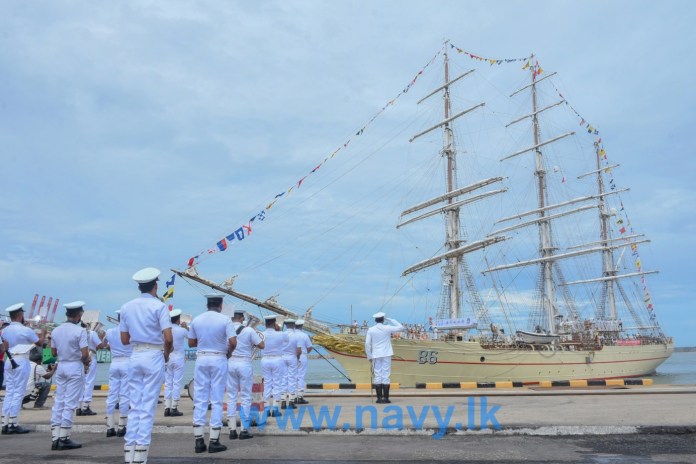In a move that can cause fresh tensions in the region, Sri Lanka has allowed the Chinese Navy training ship, Po Lang, to dock at its port, despite a 12-month moratorium imposed earlier this year on foreign research vessels, following security concerns raised by India and the United States.
Foreign Minister Vijitha Herath explained the decision to permit the Po Lang—a three-masted tall ship with a crew of 130. He emphasized that the vessel is classified as “a training vessel and not a research craft.” He stated that there has been no change in the policy regarding research vessels.
The Sri Lanka Navy announced that during their stay in Colombo, the ship’s crew would explore some of the country’s tourist attractions. Additionally, Sri Lankan Navy personnel would have the opportunity to participate in briefings about the ship’s operational functions.
The Chinese crew is scheduled to remain in Sri Lanka until Friday, engaging in activities that promote “naval exchanges and capacity building.”
The Po Lang’s voyage includes stops in various countries such as Vietnam, Indonesia, Sri Lanka, and Singapore, along with a technical layover in Hong Kong.
Ban On Research Vessels & A Surprising U-Turn
In August 2022, the Chinese naval vessel Yuan Wang 5 docked at Sri Lanka’s Hambantota port for replenishment. According to New Delhi, the Yuan Wang 5 was a “spy ship,” noting its specialization in spacecraft tracking.
Then again, In October 2024, the Chinese research ship Shi Yan 6 arrived at Colombo port for geophysical research in collaboration with Sri Lanka’s National Aquatic Resources Research and Development Agency (NARA). The US and India had expressed concerns to Sri Lanka.
As a result, In January 2024, Sri Lanka implemented a ban on foreign research vessels due to frequent requests from Chinese surveillance ships. That same month, Sri Lanka denied entry to China’s research ship Xiang Yang Hong 3, which then moved to the Maldives.
However, in July 2024, Sri Lanka announced plans to lift the ban on foreign research ships starting the following year. Foreign Minister Ali Sabry made this announcement during his visit to Japan, as reported by NHK World Japan (Japan Broadcasting Corporation).

He emphasized that Sri Lanka cannot apply different rules to different countries and cannot block only China, asserting that the nation will not take sides in disputes between other countries.
The moratorium will officially end in January next year, after which foreign research ships will be allowed access to Sri Lankan ports.
The Strategic Importance Of Sri Lanka
Situated at a crucial juncture in the Indian Ocean, Sri Lanka serves as a vital waypoint for maritime traffic between Southeast Asia and West Asia, forming an integral part of the global trade route. This strategic positioning has made it a focal point of geopolitical tension.
At the end of August 2024, both Indian and Chinese warships docked simultaneously in Colombo, highlighting this strategic significance.
India’s guided-missile destroyer, INS Mumbai, arrived in the Sri Lankan capital coinciding with the presence of three Chinese vessels, including the destroyer Hefei and two amphibious landing platform docks, Wuzhishan and Qilianshan, with a combined crew of nearly 1,500 personnel.
The Times of India noted that “Chinese warships, including those from its anti-piracy escort forces, are spending significantly more time in the Indian Ocean Region (IOR) than before.”
“The arrival of the warships (Indian and Chinese warships) is very good for Sri Lanka as a regional player,” Minister of Foreign Affairs Ali Sabry said while talking to regional media at a press conference. “The Americans are coming, the Indians are coming, and now the Chinese are coming. This means that Sri Lanka is important, and Colombo has become a hub once again,” he added.
China’s interest in establishing a foothold in Sri Lanka has raised alarms, particularly in India. Reports have emerged suggesting potential plans for a Chinese military base at Hambantota Port.
A study by AidData, a research lab at the College of William & Mary in Virginia, suggested that China might seek to establish a naval base at Hambantota Port within the next two to five years.
This growing Chinese presence near India’s southern coastline has heightened concerns in New Delhi. However, diplomatic efforts have borne fruit: in April 2024, Sri Lanka leased Hambantota Airport—originally built with Chinese loans—to a consortium of Indian and Russian firms.
The Sri Lankan cabinet awarded a 30-year lease to a joint venture between India’s Shaurya Aeronautics and Russia’s Airports of Regions Management Company. The project was funded by high-interest Chinese commercial loans and cost $209 million, with $190 million sourced from the Exim Bank of China.
India’s Objection
India remains wary of China’s increasing presence in the Indian Ocean and its influence over strategically positioned nations like Sri Lanka and the Maldives. These concerns have deepened due to recent political instability in the region and strained relations over visits by Chinese naval vessels.
Adding to these worries are reports suggesting that China is considering building a radar base at Dondra Bay, Sri Lanka’s southernmost point, to monitor Indian naval activities and UK-US military installations on Diego Garcia.
Research vessels conducting scientific studies can also double as tools for naval reconnaissance, using their equipment to gather intelligence on foreign military assets and vessels operating nearby.
Although Sri Lanka has denied these claims, military cooperation between China and Sri Lanka has continued to grow. As Sri Lanka navigates its strategic importance, the decisions it makes will continue to have significant implications for the geopolitical landscape of the Indian Ocean region.









